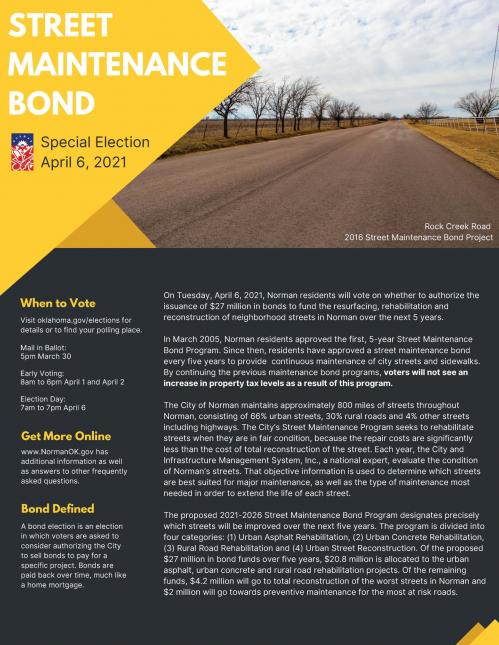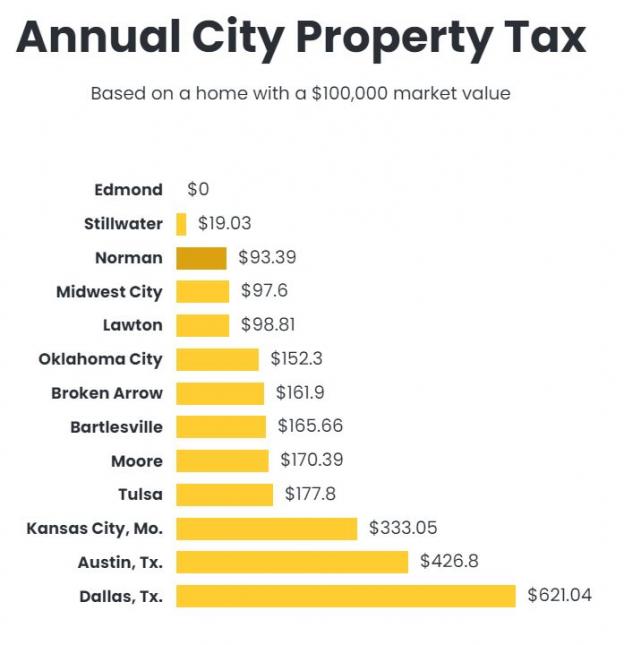On Tuesday, April 6, 2021, Norman residents voted to approve the issuance of $27 million in bonds to fund the resurfacing, rehabilitation and reconstruction of neighborhood streets in Norman over the next 5 years.
In March 2005, Norman residents approved the first, 5-year Street Maintenance Bond Program. Since then, residents have approved a street maintenance bond every five years to provide continuous maintenance of city streets and sidewalks. By continuing the previous maintenance bond programs, voters will not see an increase in property tax levels as a result of this program.
The City of Norman maintains approximately 800 miles of streets throughout Norman, consisting of 66% urban streets, 30% rural roads and 4% other streets including highways. The City’s Street Maintenance Program seeks to rehabilitate streets when they are in fair condition, because the repair costs are significantly less than the cost of total reconstruction of the street. Each year, the City and Infrastructure Management System, Inc., a national expert, evaluate the condition of Norman’s streets. That objective information is used to determine which streets are best suited for major maintenance, as well as the type of maintenance most needed in order to extend the life of each street.
The 2021-2026 Street Maintenance Bond Program designates precisely which streets will be improved over the next five years. The program is divided into four categories: (1) Urban Asphalt Rehabilitation, (2) Urban Concrete Rehabilitation, (3) Rural Road Rehabilitation and (4) Urban Street Reconstruction. Of the proposed $27 million in bond funds over five years, $20.8 million is allocated to the urban asphalt, urban concrete and rural road rehabilitation projects. Of the remaining funds, $4.2 million will go to total reconstruction of the worst streets in Norman and $2 million will go towards preventive maintenance for the most at risk roads.
Planned Street Improvements
The roadway improvements in the 2021 Bond election were developed using the city’s Pavement Management Program which uses technical information to rate and rank streets based upon their condition.
Some highlights of the proposed $27 million street maintenance projects are:
- $4.2 million will be used for roadway reconstruction
- $2 million will be used for preventive maintenance
- $20.8 million will be used for rehabilitation/maintenance
- 25% or $5.2 million for asphalt streets
- 59% or $12.2 million for concrete streets
- 15% or $3.1 million for rural roads
- Bicycle safety modifications where applicable
- Minor storm drainage improvements
- Accessibility for the disabled will be prioritized
- Streets located throughout Norman
- Collaboration with Cleveland County on rural roads
A typical street maintenance/rehabilitation project in a neighborhood might require 30 days for completion. Residents will be notified well in advance. Access to properties will be maintained throughout the projects.
Election Brochure

An educational brochure was sent to every household in Norman, informing them of the August 6, 2021 election. You can view a copy of the election brochure here.
Frequently Asked Questions
What is the total amount of this bond program?
The total amount of this bond program is $27 million.
Where are the bond projects located?
The bond projects are located throughout Norman . The vast majority of the projects are targeted in residential neighborhoods as identified in a previous citizen satisfaction survey. You can see a specific list of projects in the ballot ordinance here.
When will the projects begin?
Work will begin on the first projects in August 2021 with the full list of street maintenance bond projects being completed in 2026.
Is there a schedule of when specific streets will be repaired?
Yes. The City has developed a five year schedule of projects throughout all parts of Norman. Search the map above to see the locations of each proposed project.
How do I know which streets will be repaired?
By law, the City must provide the improvements at the specific locations identified in the bond ordinance and voted on by the citizens. You can view the ordinance with the listed projects at here.
How do Norman property taxes relate to other cities in the region?

Norman's property tax rate is ranked third lowest of twelve regional peer cities.
Do the bond projects include costs for inflation?
Yes, the project budgets include the anticipated cost for inflation over the proposed five-year program.
How will this effect my property tax rate?
There will be no increase to your tax rate. The proposed street maintenance program is basically a continuation of the five-year street resurfacing bond program that was approved by the voters in 2005 and re-authorized in 2010 and 2016. Currently, the owner of a home with a market value of about $100,000 is paying approximately $5.75 per month in property taxes to repay these existing bonds (an average mill levy rate of 6.31 mills). If the 2021 proposal is approved by voters, the estimated tax level will not increase as a result of the five-year bond proposal.
Can the City repair residential streets without this bond?
Funding from the previous Street Maintenance Bond programs has made up approximately 50 to 60% of the City's street maintenance funds. The City also has other funding sources that are used to improve and maintain urban and rural roads. The annual Capital Improvements Program and the annual operating budget for the City Public Works/Streets Division allocate funds for the maintenance of city streets, as well. However, these other funding sources are not enough to maintain Norman's network of 800 miles of streets.
Do the City and Cleveland County work together on street maintenance?
The City and Cleveland County work together on the maintenance and rehabilitation of rural city streets in Norman through an interlocal agreement approved annually. In addition to routine maintenance, the proposed bond program will be able to rehabilitate twice as many rural roads in east Norman with the use of city and county labor and equipment than otherwise could be accomplished with contract services.
